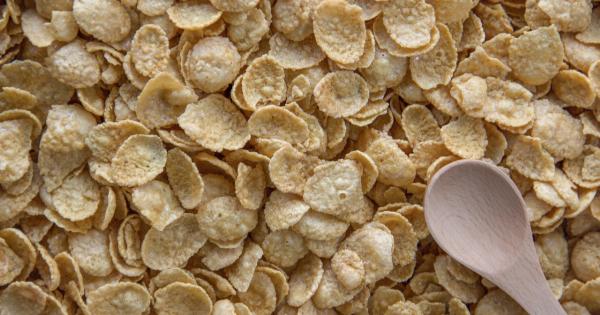Nutrition plays a critical role in maintaining our overall health and well-being. Consuming nourishing foods on a regular basis is essential for providing our bodies with the necessary nutrients to function optimally.
A healthy diet not only supports our physical health but also has a positive impact on our mental and emotional well-being.
Understanding the Need for Improved Guidelines
Over the years, dietary guidelines have evolved to keep up with the latest scientific research and address emerging health concerns. One notable area of focus in recent times has been reducing sodium intake and increasing dietary fiber.
These changes aim to address the growing concerns around the negative impact of excessive salt consumption and insufficient fiber in our diets.
The Dangers of Excess Salt
High sodium intake has been strongly linked to various health issues, including hypertension, cardiovascular diseases, kidney problems, and strokes.
The average salt intake in many countries exceeds the recommended limits, primarily due to the widespread consumption of processed and packaged foods. By reducing salt in our diets, we can effectively lower blood pressure, reduce the risk of heart diseases, and improve overall cardiovascular health.
The Benefits of Fiber
Dietary fiber, on the other hand, plays a crucial role in maintaining digestive health, promoting regular bowel movements, and preventing constipation.
It also aids in weight management by increasing satiety, reducing overeating, and supporting healthy digestion. Additionally, fiber-rich diets have been associated with a decreased risk of developing chronic conditions such as type 2 diabetes, certain types of cancer, and diverticular disease.
Improved Guidelines for Salt Reduction
In light of these health concerns, health organizations and governments around the world have been implementing improved guidelines to reduce salt consumption. These guidelines include recommendations for both individuals and food manufacturers.
For individuals, it is advised to limit the use of salt in cooking and opt for low-sodium alternatives. Reading food labels carefully can also help identify high-sodium products and make informed choices. Food manufacturers are encouraged to gradually decrease the amount of salt added to their products, ensuring a gradual shift towards healthier options.
Enhancing Fiber Intake
Increasing dietary fiber can be done by incorporating more whole grains, fruits, vegetables, legumes, nuts, and seeds into our daily meals. These foods are naturally rich in fiber and offer various other nutrients that support overall health.
It is recommended to gradually increase fiber intake to prevent digestive discomfort and allow the body to adjust. Drinking plenty of water alongside fiber intake is also important to promote proper digestion.
The Impact of Improved Guidelines
Embracing the decreased salt and enhanced fiber guidelines can have significant positive impacts on our health. By reducing salt intake, we can lower the risk of developing hypertension and related cardiovascular diseases.
Moreover, a fiber-rich diet promotes digestive health and facilitates healthy weight management. Additionally, such dietary changes contribute to disease prevention and overall well-being.
Cardiovascular Health
Reducing salt intake is crucial for maintaining cardiovascular health. Excessive salt consumption can lead to increased blood pressure, putting a strain on the heart and blood vessels.
By following the improved guidelines for salt reduction, individuals can decrease their blood pressure levels, lower the risk of heart diseases, and improve overall cardiovascular well-being.
Weight Management
A diet rich in fiber can be beneficial for weight management. High-fiber foods tend to be more filling and can help control appetite, preventing overeating and promoting a healthy body weight.
By incorporating fiber-rich foods into our meals, we can improve satiety, support weight loss efforts, and maintain a healthy body composition.
Digestive Health
Fiber plays a crucial role in maintaining good digestive health. It adds bulk to the stool, facilitating regular bowel movements and preventing constipation.
By increasing fiber intake, individuals can alleviate digestive issues and promote a healthy gastrointestinal system. Moreover, certain types of fiber act as prebiotics, nourishing beneficial gut bacteria and supporting a balanced gut microbiome.
Disease Prevention
The improved guidelines for decreased salt and enhanced fiber intake also contribute to disease prevention. By reducing salt intake, individuals can lower the risk of developing hypertension, cardiovascular diseases, and related complications.
Similarly, fiber-rich diets have been associated with a decreased risk of chronic conditions such as type 2 diabetes, certain types of cancer, and diverticular disease. By incorporating these guidelines into our daily routines, we can proactively protect our health and well-being.
Incorporating Improved Guidelines into Your Diet
Transitioning to a diet with decreased salt and enhanced fiber can be achieved through simple yet effective changes. Here are some tips to help you incorporate these improved guidelines into your daily routine:.
- Choose whole, unprocessed foods: Opt for whole grains, fresh fruits and vegetables, legumes, nuts, and seeds instead of processed and packaged foods that are often high in sodium.
- Read food labels: Be mindful of the sodium content in packaged foods by reading food labels carefully. Look for low-sodium or no-added-salt options.
- Experiment with herbs and spices: Enhance the flavor of your meals with herbs, spices, and other seasonings instead of relying on salt for taste. This can add variety and depth to your culinary experience.
- Gradually reduce salt: If you’re used to consuming a high-salt diet, start by gradually reducing the amount of salt you add to your meals. Over time, your taste buds will adjust to the lower levels of salt.
- Add fiber-rich ingredients: Look for opportunities to add fiber-rich ingredients to your dishes. Include more whole grains, fruits, vegetables, legumes, nuts, and seeds in your meals. Replace refined grains with whole grain alternatives.
- Stay hydrated: When increasing fiber intake, it is important to drink plenty of water to aid in digestion and prevent discomfort. Aim to drink at least 8 cups of water per day.
- Plan your meals: Take time to plan your meals and ensure they include a balance of nutrients, including fiber-rich foods. Meal planning can help you stay on track and make healthier choices throughout the week.
- Be patient with your body: It takes time for the body to adjust to dietary changes, especially when increasing fiber intake. Be patient and give your body time to adapt.
- Consult a healthcare professional: If you have specific dietary concerns or health conditions, it is always helpful to seek guidance from a healthcare professional or registered dietitian who can provide personalized advice.
Conclusion
Improved guidelines encouraging decreased salt and enhanced fiber intake in nourishing foods have a significant impact on our health and well-being.
By reducing salt consumption and increasing fiber intake, we can improve cardiovascular health, support weight management, maintain digestive health, and prevent chronic diseases. By incorporating these guidelines into our daily lives, we can take an active role in promoting our own health and enjoying the benefits of nourishing foods.






























